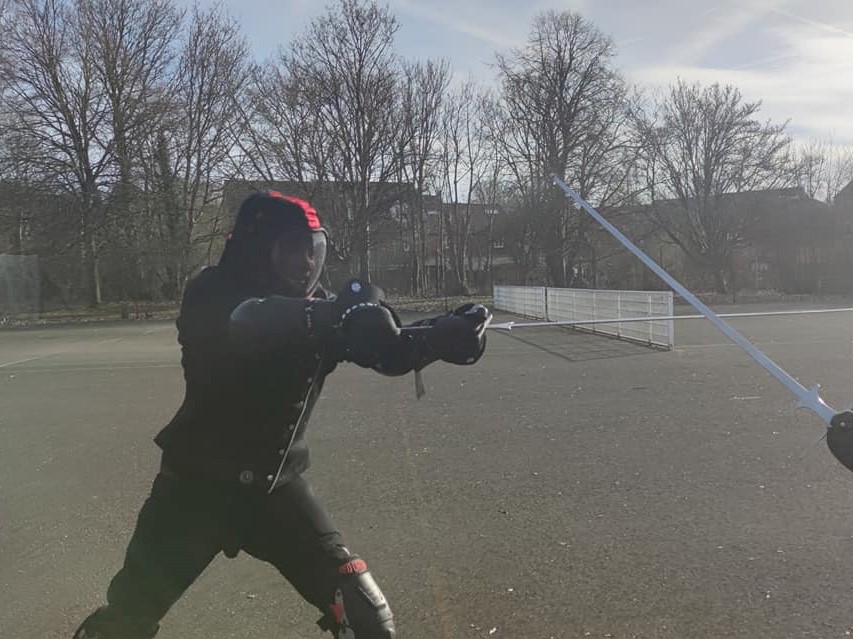
Last summer after a gruelling year of work, plus extra-curricular training courses, hunched over a computer, I felt the need to find a new interest, something active that didn’t involve a screen of any kind.
Despite getting on a bit I wasn’t ready to take up golfing (I will never be ready), nor was I ready to try cycling (all that lycra) so I was casting about for something to do when a friend mentioned they’d taken up sword fighting. More specifically they had started to explore Historical European Martial Arts (HEMA), a discipline that explores the medieval fighting texts of sword, dagger, buckler etc.
Now that sounded good so I started googling. I found a couple of schools in Oxford but I settled on the School of the Sword.
One evening in late summer my sword fighting education began with nylon swords, the school’s gloves and masks, and by being introduced to the techniques laid out in the various manuals of Fiore dei Liberi, a late fourteenth century knight and fencing master. Soon we were attempting to learn the various cuts and guards necessary to survive a longsword bout including:
- Punte, the thrust.
- Mandritto sottani, an upwards cut from right to left.
- Posta di dente zenchiaro mezana or middle boar’s tooth guard.
A combination of drills covering cuts, guards and footwork gradually sunk in over the next few weeks, new friends were made and many discussions were had on the best gloves, jackets and swords to get. For some, learning not to hit too hard was the issue, for others, myself included, it was learning to actually hit and not just cut in your opponent’s general direction. Also learning not to shut your eyes when getting hit.
Finally, we reached the safety test, which I managed to pass and with some investment in gear – we were rightly advised that protection should be bought before swords, however tempting the latter were – we were ready. Ready to put the learning into practice and spar with metal swords.
The longswords we were using were federschwert, the longsword equivalent of a foil. Narrow bladed, flaring out at the hilt and with plenty of spring so it bends when a thrust lands, they make a much more pleasing sound than a nylon sword when they clash with your opponent’s blade or land on the top of their mask.

A whole new world has opened up. We’ve been taught the beginnings of armizare (unarmed combat), rondel dagger work and now the side sword based on the teaching of Giovanni Dall’Agocchie who published his work in the 1570s. Thursday is drills, learning and some sparring, putting what we’ve learnt into practice. Sundays is sparring in the park where I’ve fought with sword and buckler, rondel, rapier and dussack, as well as practicing my longsword. I’ve got various bruises through all the padding and I now understand the expression ‘your ears are ringing’ from being hit, but it is incredibly exciting to pit yourself against an opponent and very satisfying when a well-executed cut lands or guard works.
I’m now starting to explore the various texts available as well as delving deep into YouTube and there is some interesting stuff:
- The Knight Shop - where I've bought a lot of kit!
- https://www.youtube.com/@FedericoMalagutti
- By the Sword (Podcasts, events and training courses)
- Guy Windsor books
Anymore suggestions please put them in the comments! I’m still learning and keen to see more.
As this is an Osprey blog I should mention a few of our titles that are relevant:
The Medieval Longsword by Neil Grant acts as an introduction to the sword, as a weapon and “as a tactical, economic and social artefact” It includes an overview of the dominant Italian and German traditions studied today.
Although our school leans towards the black there is a lot more colourful kit available. For anyone who wants to evoke the Renaissance in their swordplay, or learn about the turmoil of the period, what about: Renaissance Armies in Italy
For those wishing to combine wargaming and swashbuckling why not play as Border Reivers, Conquistadors, Landsknechts, Aztecs, French Musketeers, Caribbean Pirates and many more, in scenarios that evoke classic engagements of the genre: En Garde!

Comments
You must be logged in to comment on this post. Click here to log in.
Submit your comment